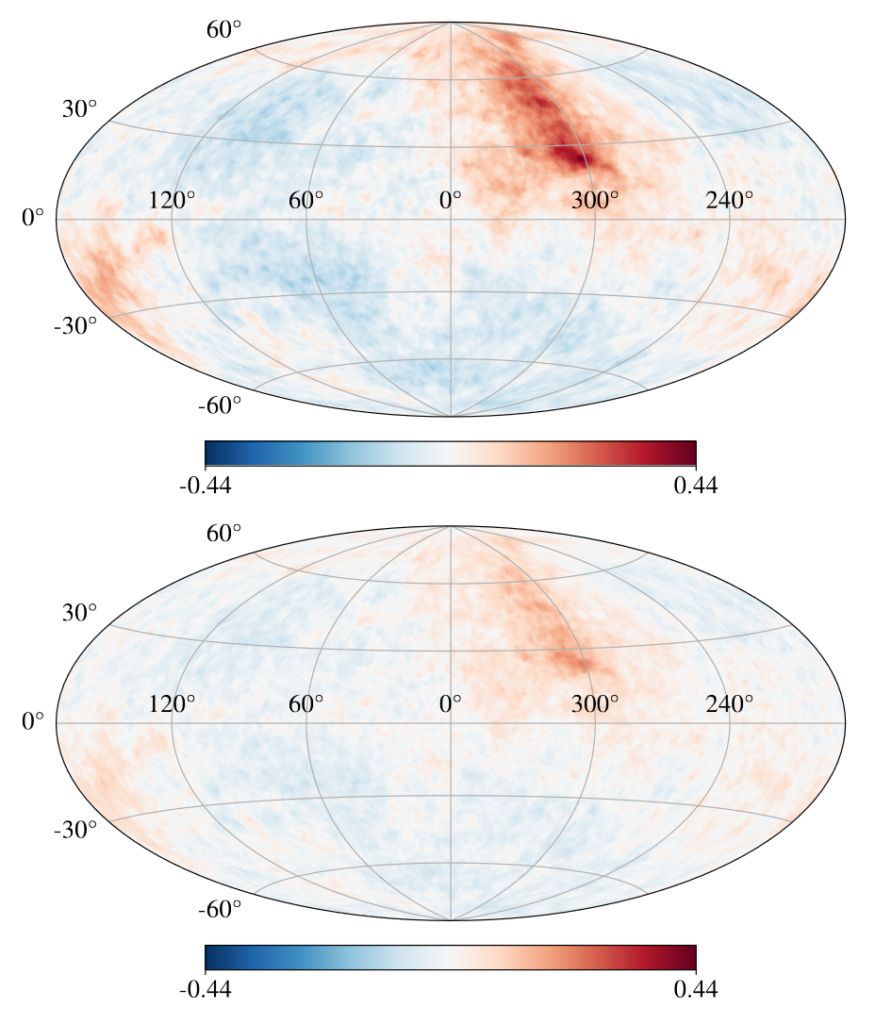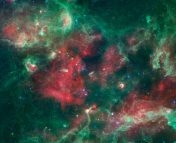Paper Title: Neutrino anisotropy as a probe of extreme astrophysical accelerators
Authors: Marco Stein Muzio and Noemie Globus
First author institution: Department of Physics, Department of Astronomy and Astrophysics, and Institute of Gravitation and the Cosmos, Center for Multi-Messenger Astrophysics, at Pennsylvania State University, University Park, PA 16802, USA
Status: On ArXiv (open access)
The search for extreme particle accelerators
In 1911, when Victor Hess first ascended in a balloon, he found that the radiation he measured increased as he went up in the atmosphere, and thus cosmic rays were discovered. Cosmic rays are high energy particles which are produced in particle accelerators far more powerful than any we can construct on Earth.
However, where exactly these high energy cosmic rays are coming from remains an unsolved mystery in astrophysics. We can look for these high energy particle accelerators (called PeVatrons, because they accelerate particles above 1 PeV = 1015 electronvolts) by closely studying the cosmic rays and other signals we observe on Earth.
At these high energies, cosmic rays frequently run into photons or other surrounding material as they travel toward Earth.These interactions produce gamma rays and tiny, electrically neutral particles called neutrinos, which also have ultra-high energies (PeV to more than an EeV, or 1018 electronvolts). Unlike cosmic rays, neutrinos rarely interact with other particles and also are unaffected by magnetic fields, and therefore point back to their source.
Today’s paper looks at these ultra-high-energy neutrinos, and discusses how experiments can use them to search for these elusive PeVatrons. The paper’s authors develop a model to find out where these ultra-high-energy neutrinos might come from, depending on how their respective sources are expected to evolve in the universe.
Evolution of neutrino sources
By modeling the distribution of neutrino sources in the universe, the authors look at how the flux of ultra high energy neutrinos (flux = the number of neutrinos per unit energy per unit time) changes when we look at different locations in the sky. This so-called “diffuse” flux measures the total neutrino flux, instead of that of a particular astrophysical source (say, a galaxy or a supernova). Experiments can measure if the flux is largely the same everywhere (isotropic) or has variation in different directions (anisotropic). The degree of anisotropy helps to understand the distribution of PeVatrons in our universe.
The authors’ model can tell us about how these neutrino sources evolve over time – meaning, if we look back over the history of the universe, are there more and more neutrino sources? Are there the same number? What does our universe look like in neutrinos at different redshifts?
The authors’ model takes this into account by looking at what is called the source evolution. If there are more sources that have evolved over time, then more of them will be at low redshifts – this is called “negatively evolving”. On the other hand, if more sources are seen at high redshifts, this would be “positively evolving”. These two cases can be seen in Figure 1. In the case of a positive evolution, we expect sources to be more evenly distributed over the sky, which would be reflected in the flux we see. On the other hand, if we have a negative evolution case with more sources nearby, then we expect these sources to follow the distribution of matter nearby us, and we would see the imprint of this in the flux. In this case, we would see anisotropy in the diffuse flux.

In this way, the authors argue that when we can measure the anisotropy in the neutrino sky, we can better understand the most extreme sources producing the neutrinos and ultra-high-energy cosmic rays in our universe.
An experimental challenge
Although this method is very exciting and provides a lot of interesting information about potential PeVatrons, the authors point out that this measurement poses some significant experimental challenges.
Thus far, the diffuse flux of neutrinos has only been experimentally measured up to about 10 PeV, while this analysis uses neutrinos above 10 PeV. The authors also show that their method requires many ultra-high-energy neutrinos – more than 300 neutrinos! Detecting neutrinos is very difficult, because neutrinos interact so rarely, so detecting this many ultra-high-energy neutrinos poses a significant experimental challenge. In order to make a measurement like this, we need new, next generation experiments such as IceCube-Gen2 or the Giant Radio Array for Neutrino Detection (GRAND).
Astrobite edited by Konstantin Gerbig
Featured Image Credit: Fig 1 (top) in Muzio and Globus 2023




